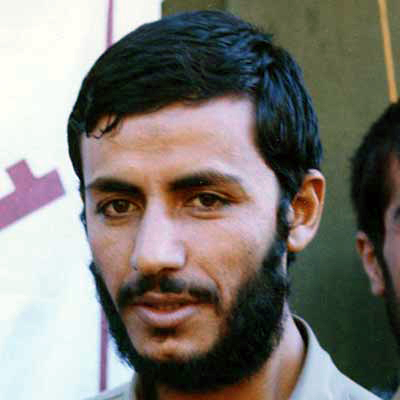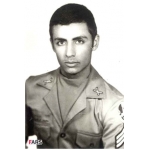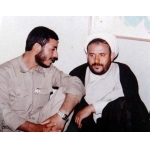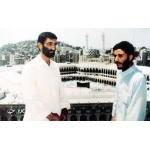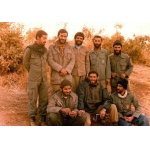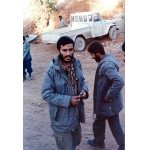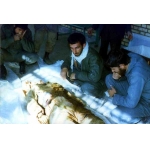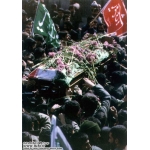People
Hemmat, Muhammad Ebrahim
: Zaynab Ahmadi
560 Views
Muhammad Ebrahim Hemmat, the commander of the 27th Muhammad Rasulullah (pbuh) Division of the Islamic Revolutionary Guard Corps (IRGC), was martyred on March 7, 1984, during Operation Kheibar.
Muhammad Ebrahim Hemmat was born on the 2nd of April 1955 in Shahreza, Isfahan. He earned a diploma in 1973. Later, he graduated from a two-year teacher training program at Isfahan University and returned to Shahreza. In 1975, he started serving the compulsory military service at the Lashkarak Garrison in Tehran and later at the Artillery Group Garrison in Isfahan. After completing his military service in 1977, he began teaching at a school in Shahreza. He fled to Shiraz in 1978, as regime agents were pursuing him for toppling the statue of Muhammad Reza Pahlavi in Isfahan’s main square. Following the victory of the Islamic Revolution, Hemmat played a key role in organizing local defense committees in Shahreza and surrounding villages.
In 1979, after the formation of the Isfahan IRGC, Hemmat was assigned by the Isfahan Department of Education to serve as the head of the propagation unit of the Shahreza IRGC. Later on, he went to Khuzestan to cooperate with the Khuzestan IRGC in combating anti-revolutionaries. From the summer to mid-fall of 1979, Hemmat traveled to impoverished villages in Sistan and Baluchestan, where, with the financial support of clerics, he built two public baths and a mosque. In late May 1980, he went to Kermanshah Province to deal with anti-revolutionaries and, under the command of Muhammad Boroujerdi (the commander of IRGC Region 7), was appointed head of the propagation and public relations unit of the Paveh IRGC, actively participating in the fights against the Mujahedin-e Khalq Organization (Munafiqeen) and Kurdish Democratic Party forces.[1]
In the spring of 1980, Hemmat was appointed commander of the Paveh IRGC, and from December 1980 to January 1981, he led the forces in the Oramanat and Paveh.[2] With the onset of the Iran-Iraq War, he participated in numerous operations in the western part of the country. One notable operation was Nari, aimed at liberating the Kamanjir Heights and highlands above Nowdesheh (a town in Paveh) from domestic anti-revolutionaries. Between April 27 and May 11, 1981, he participated in two operations targeting Nowdesheh village as well as the Kaletangeh and Siah Heights. He also played a role in liberating the Kaveh Zahra and Dalani Mansour Heights.
In 1981, Nasser Kazemi (the Paveh IRGC commander) assigned Hemmat to lead the Paveh operational unit. On July 3, 1981, Operation Ruhullah, carried out in Nosud to liberate the Shamshi Heights and destroy Iraqi forces, was successfully conducted under the command of Nasser Kazemi and Hemmat.[3]
In September 1981, Muhammad Boroujerdi appointed Hemmat as the commander of the Paveh IRGC. As the two IRGC units in Paveh and Marivan shared a boundary in terms of their operational activities, Hemmat collaborated closely with Ahmad Motevaselian (the Marivan IRGC commander) in activities such as reconnaissance of border routes between Marivan and Paveh, as well as the Panjwin plain and the Toveileh and Biyara routes in Sulaymaniyah, Iraq. In late September 1981, Hemmat and other commanders performed the hajj.[4]
Operation Muhammad Rasulullah (pbuh), led by Hemmat and Motevaselian, was launched on January 2, 1982, in the Marivan-Paveh border area to temporarily capture the Toveileh settlement in eastern Sulaymaniyah Province, Iraq, and concluded successfully on January 5.[5]
On January 4, Hemmat met Mohsen Rezaei (the IRGC commander-in-Chief) to discuss the formation of a maneuver brigade for the Khuzestan IRGC. As a result, Hemmat, along with Ahmad Motevaselian, visited the operational areas in Khuzestan. Shortly afterwards, on January 13, Hemmat married Jila Badihian.[6]
The 27th Muhammad Rasulullah (pbuh) Brigade was founded on February 6, 1982, with Ahmad Motevaselian as its commander and Mahmoud Shahbazi as his deputy. Muhammad Ebrahim Hemmat was appointed as the brigade's chief of staff. The brigade's core personnel were initially positioned in Dezful and later moved to the Do-Kouheh Garrison.[7]
Hemmat commanded the right flank of the 27th Brigade during Operation Fath al-Mubin, which was carried out on March 21, 1982, in Dezful. Under his leadership, the offensive battalions successfully liberated the key heights of Shavurieh, Dehliz, and Peak 350. Together with Motevaselian and Shahbazi, he also led the forces fighting against successive tank counterattacks by Iraq's 10th Armored Division in the Dasht Abbas area, ensuring the successful defense of the brigade's lines.
In Operation Beit al-Muqaddas carried out on April 29, 1982, Hemmat oversaw 14 battalions as the deputy commander of the 27th Muhammad Rasulullah (pbuh) Brigade.[8] Following Israel's widespread invasion of Lebanon on June 6, 1982, the brigade's forces, led by Motevaselian and Hemmat, were deployed to Lebanon on June 11, upon orders from the IRGC commander-in-Chief, Mohsen Rezaei. After Motevaselian's abduction, the forces returned to Iran.[9]
As soon as he returned to Iran, Hemmat reorganized the 27th Brigade, forming a new battalion, Habib ibn Mazahir, at Imam Hassan (as) Garrison and moving to Ahvaz.[10] On the 6th of July 1982, the brigade was prepared to conduct the third phase of Operation Ramadan.[11]
On July 14, 1982, Hemmat was appointed commander of the 27th Muhammad Rasulullah (pbuh) Brigade.[12] Under his leadership, the brigade captured the tactical headquarters of Iraq's 10th Armored Division and destroyed all its equipment.[13]
The fifth phase of Operation Ramadan took place on July 28, 1982, with Hemmat leading the battalions as the brigade commander.[14]
In late September 1982, Hemmat was appointed commander of the Nasr Division, which consisted of the 27th Muhammad Rasulullah (pbuh), 31st Ashura, 21st Imam Reza (as), and 18th Javad al-Aemah (as) Brigades. He relocated the Nasr Division's headquarters to the Somar.[15]
From October 1 to November 16, 1982, Hemmat participated in two consecutive operations, Moslim ibn Aqil and Zain al-Abidin (as). Although the Iranian forces could not defeat the enemy, they managed to secure strategic heights overlooking the city of Mandali in Iraq.
In late November 1982, Mohsen Rezaei appointed Hemmat as the commander of the 11th Qadr Corps, which included the 31st Ashura Division, the 27th Muhammad Rasulullah (pbuh) Division, and the 10th Seyyed al-Shuhada (as) Brigade. In the meantime, the 27th Muhammad Rasulullah (pbuh) Brigade was upgraded to the 27th Muhammad Rasulullah (pbuh) Division.[16]
On February 6, 1983, when the preliminary Operation Valfajr was conducted in Fakkeh, Hemmat led the 11th Qadr Corps. Following the failure of the operation, the Valfajr 1 was launched in southern Fakkeh on April 10, 1983. While Iranian forces inflicted heavy losses on the Baathist army, the obstacles created by the enemy forces hindered the achievement of all objectives.[17]
In the summer of 1983, the three combat Qadr corps were disbanded, and Hemmat resumed command of the 27th Division. Since the next operations were planned to be carried out in certain areas of the western part of the country, Hemmat relocated his division from the Do-Kouheh Garrison to the Martyr Boroujerdi Camp in Qalajeh, a mountainous area between Eslamabad-e Gharb and Ilam.
Following orders from the war's senior commanders, Hemmat was deployed to the Marivan-Panjwin operational area to participate in Operation Valfajr 4. In the third phase of this operation, his division was tasked with capturing the strategically critical Kani-Manga Heights in Iraqi territory. On November 4, 1983, the division successfully captured Height 1866 of the Kani-Manga mountains and the canyon in between.[18]
In late December 1983, Hemmat left the west (Marivan-Panjwin) for the south to organize the necessary preparations for Operation Kheibar. The operation began on February 22, 1984, in Hoor al-Hoveizeh, north of Basra. Under Hemmat's command, the 27th Division was tasked with breaking through the enemy's strong defensive line in Talaieh, connecting this axis to the southern Majnoon Island, and capturing the Talaieh Bridge. However, the Iranian troops could not achieve the objectives of the operation.[19] Therefore, the Khatam al-Anbia (pbuh) Headquarters ordered them to retreat and launch another operation from Majnoon Island, which was Iran's only advantage at the time. Iraq had heavily fortified the island, and Hemmat's mission was to connect the eastern edge of southern Majnoon Island to its center. However, progress was slow due to insufficient equipment.[20]
On March 7, 1984, Muhammad Ebrahim Hemmat, accompanied by Seyyed Hamid Mirfazeli (commander of the 41st Tharallah Division's Intelligence-Operations Unit), headed towards the front lines on a motorcycle to request reinforcements. On their way to that axis (on southern Majnoon Island), a bullet struck Hemmat in the face, and he was martyred. He was laid to rest in the Martyrs' Cemetery in Shahreza, Isfahan.[21]
The Haj Hemmat Hosseiniyeh, located in the Do-Kouheh area, serves as a memorial to this great martyr. A large portrait of Hemmat is also displayed on the wall of the building that used to be his command post in Do-Kouheh.[22]
On the sixth day of Sacred Defense Week in 1989, Ayatollah Khamenei posthumously awarded Hemmat the Fath Medal.[23]
Numerous books have been published about this commander, including Be Ravayat-e Hemmat (In the Words of Hemmat), Setaregan-e Zamin (Stars of the Earth), and Raz-e Mandegari-ye Shahid Hemmat (The Secret of Martyr Hemmat’s Legacy), which focus on his statements and speeches. The book Hampay-e Saeqeh (Alongside the Thunder) covers the lives of ten commanders of the 27th Muhammad Rasulullah (pbuh) Division, including Hemmat.[24]
In March 2006, a memorial event for Hemmat and 725 martyrs from Shahreza was held in the same city.[25] One of Tehran's main highways, extending from the east, at the intersection of Pasdaran Street and Shahid Zeynuddin Highway, to the Tehran-Karaj Highway in the west, is named after Muhammad Ebrahim Hemmat.[26] A highway in Isfahan also bears his name.[27]
Hemmat’s father and mother passed away in December 2004 and September 2020, respectively.[28]
[1] Behzad, Hussain, Be Ravyat-e Hemmat (In the Words of Hemmat), Vol. 1, Tehran: Saeqeh, 1394, Pp. 19–21.
[2] Behzad, Hussain, Babaei, Gol Ali, Hampa-ye Saeqeh (Alongside the Thunder), Tehran: Hozeh Honari, 27th Division of Muhammad Rasulullah (pbuh), 1379, p. 805.
[3] Babaei, Gol Ali, Mah Hamrah-e Bacheha-ast (The Moon Is with the Comrades), Tehran: Saeqeh, 1391, p. 47; Behzad, Hussain, Be Ravyat-e Hemmat (In the Words of Hemmat), p. 22; Behzad, Hussein, Babaei, Gol Ali, Hampa-ye Saeqeh (Alongside the Thunder), p. 56; Darvishi Satelani, Farhad, Muhammadpour, Muhammad, Rouzshomar-e Jang Iran va Iraq (Chronicle of the Iran-Iraq War), Book 13, Vol. 1: Tadavom-e Eshghal va Bohran (Continuation of Occupation and Crisis), Vol. 13, Part 1, Tehran: Sepah Pasdaran Enqelab Eslami, Markaz-e Asnad va Tahqiqat-e Defa Muqaddas, 1397, p. 89.
[4] Babaei, Gol Ali, Mah Hamrah-e Bacheha-ast (The Moon Is with the Comrades), Pp. 57 and 58.
[5] Ibid, Pp. 70 and 71.
[6] Behzad, Hussain, Be Ravyat-e Hemmat (In the Words of Hemmat), p. 24.
[7] Babaei, Gol Ali, Mah Hamrah-e Bacheha-ast (The Moon Is with the Comrades), p. 72.
[8] Ibid, Pp. 76–79.
[9] Behzad, Hussein, Be Ravyat-e Hemmat (In the Words of Hemmat), p. 25; Babaei, Gol Ali, Dar Hale-i Az Ghobar (In a Haze of Dust), Tehran: Saeqeh, 1391, p. 160.
[10] Babaei, Gol Ali, Zarbate Motaqaabel (Counterblow), Tehran: Soreh Mehr, 1386, Pp. 83 and 84.
[11] Babaei, Gol Ali, Mah Hamrah-e Bacheha-ast (The Moon Is with the Comrades), p. 96; Babaei, Gol Ali, Dar Hale-i Az Ghobar (In a Haze of Dust), p. 193.
[12] Hussaini, Mostafa, Zendeginame-ye Shaheed Muhammad Ebrahim Hemmat (The Biography of Martyr Muhammad Ebrahim Hemmat), Tehran: Poshtiban, 1397, p. 14.
[13] Babaei, Gol Ali, Mah Hamrah-e Bacheha-ast (The Moon Is with the Comrades), p. 97.
[14] Ibid, p. 103.
[15] Ibid, p. 121.
[16] Ibid, Pp. 123–125.
[17] Ibid, p. 145.
[18] Ibid, Pp. 154 and 157.
[19] Ibid, Pp. 182 and 185; Raeisi, Reza, Hamsafaran (Traveling Companions), Tehran: Congress for Honoring the Martyrs of the IRGC and 36,000 Martyrs of Tehran Province, 1376, p. 215.
[20] Babaei, Gol Ali, Mah Hamrah-e Bacheha-ast (The Moon Is with the Comrades), Pp. 197 and 198.
[21] Ibid, Pp. 204 and 205; Farhang-e Alam-e Shuhada (Encyclopedia of the Martyrs), Isfahan Province, Vol. 3, Tehran: Shahid, 1396, p. 2510.
[22] Ahadi, Muhammad, Bandeh-Ali, Hojjatollah, Yadman-ha-ye Defa-ye Moqaddas (Memorials of the Sacred Defense), Tehran: Shahid Major General Sayyad Shirazi Educational and Research Center, 1395, p. 51; Mahdinejad, Sara, Dokouheh, Tehran: Sazman Honari va Adabyat Defa Muqaddas, 1393, Pp. 31 and 90.
[23] Rouznameh Jomhouri-ye Eslami (Jonhouri Eslami Newspaper), No. 2993, 6 Khordad 1368, p. 12.
[24] Tabarestani Rad, Muhammad, Be Ravyat-e Hemmat va Setaregan Zamin (In the Words of Hemmat and Earth Stars), Qom: Nasayeh, 1380; Raz-e Mandegari-ye Shaheed Hemmat (The Secret of Martyr Hemmat's Legacy), Tehran: Kanoon Farhangi-Honrai Eysargaran, 1376.
[25] Khabarguzari-ye Jomhouri-ye Eslami (Jomhouri Eslami Press), News Code: 7807450, 20 Esfand 1384.
[26] Lajevardi, Seyyed Muhammad Hussain, Hamrah, Hamed, Atlas-e Jame Iran - Tehran (Comprehensive Atlas of Iran), Tehran: Ba Farzanegan, 1387, Pp. 40–49.
[27] Rouznameh Keyhan (Keyhan Newspaper), No. 20321, 11 Mehr 1391, p. 11.
[28] Ibid, No. 22569, 1 Mehr 1399, p. 3; Rouznameh Etelaat (Etelaat Newspaper), No. 232429, Dey 1383, p. 2.




